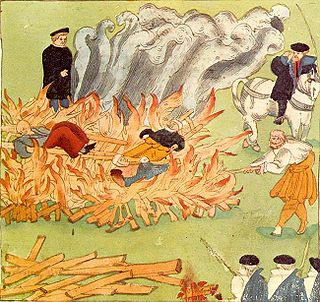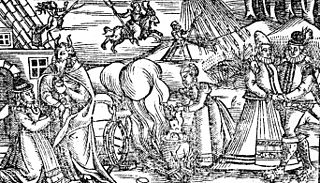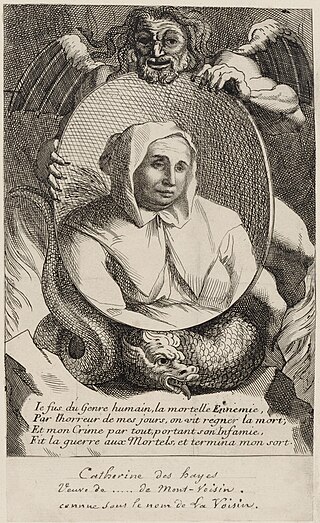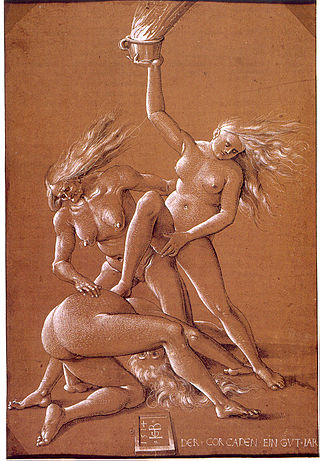
A witch-hunt, or a witch purge, is a search for people who have been labeled witches or a search for evidence of witchcraft. Practicing evil spells or incantations was proscribed and punishable in early human civilizations in the Middle East. In medieval Europe, witch-hunts often arose in connection to charges of heresy from Christianity. An intensive period of witch-hunts occurring in Early Modern Europe and to a smaller extent Colonial America, took place about 1450 to 1750, spanning the upheavals of the Counter Reformation and the Thirty Years' War, resulting in an estimated 35,000 to 50,000 executions. The last executions of people convicted as witches in Europe took place in the 18th century. In other regions, like Africa and Asia, contemporary witch-hunts have been reported from sub-Saharan Africa and Papua New Guinea, and official legislation against witchcraft is still found in Saudi Arabia and Cameroon today.

Isobel Gowdie was a Scottish woman who confessed to witchcraft at Auldearn near Nairn during 1662. Scant information is available about her age or life and, although she was probably executed in line with the usual practice, it is uncertain whether this was the case or if she was allowed to return to the obscurity of her former life as a cottar’s wife. Her detailed testimony, apparently achieved without the use of violent torture, provides one of the most comprehensive insights into European witchcraft folklore at the end of the era of witch-hunts.

The Affair of the Poisons was a major murder scandal in France during the reign of King Louis XIV. Between 1677 and 1682, a number of prominent members of the aristocracy were implicated and sentenced on charges of poisoning and witchcraft. The scandal reached into the inner circle of the king. It led to the execution of 36 people.
The Aix-en-Provence possessions were a series of alleged cases of demonic possession occurring among the Ursuline nuns of Aix-en-Provence in 1611. Father Louis Gaufridi was accused and convicted of causing the possession by a pact with the devil, and he was tortured by strappado and his bones dislocated. He was then executed on April 1611 by strangulation and his body burned. This case provided the legal precedent for the conviction and execution of Urbain Grandier at Loudun more than 20 years later. This event led to possessions spreading to other convents and a witch burning in 1611.

European witchcraft is a multifaceted historical and cultural phenomenon that unfolded over centuries, leaving a mark on the continent's social, religious, and legal landscapes. The roots of European witchcraft trace back to classical antiquity when concepts of magic and religion were closely related, and society closely integrated magic and supernatural beliefs. Ancient Rome, then a pagan society, had laws against harmful magic. In the Middle Ages, accusations of heresy and devil worship grew more prevalent. By the early modern period, major witch hunts began to take place, partly fueled by religious tensions, societal anxieties, and economic upheaval. Witches were often viewed as dangerous sorceresses or sorcerers in a pact with the Devil, capable of causing harm through black magic. A feminist interpretation of the witch trials is that misogynist views of women led to the association of women and malevolent witchcraft.
Raphael Levy was a Jewish inhabitant of the city of Metz who was burned at the stake, accused of having ritually murdered a Christian child, Didier Le Moyne. For some years after his execution, the Jewish community in Metz marked the anniversary of his death as a day of fasting.

The Basque witch trials of the seventeenth century represent the last attempt at rooting out supposed witchcraft from Navarre by the Spanish Inquisition, after a series of episodes erupted during the sixteenth century following the end of military operations in the conquest of Iberian Navarre, until 1524.
The witch trials of Vardø were held in Vardø in Finnmark in Northern Norway in the winter of 1662–1663 and were one of the biggest in Scandinavia. Thirty women were put on trial, accused of sorcery and making pacts with the Devil. One was sentenced to a work house, two tortured to death, and eighteen were burned alive at the stake.
In the early modern period, from about 1400 to 1775, about 100,000 people were prosecuted for witchcraft in Europe and British America. Between 40,000 and 60,000 were executed. The witch-hunts were particularly severe in parts of the Holy Roman Empire. Prosecutions for witchcraft reached a high point from 1560 to 1630, during the Counter-Reformation and the European wars of religion. Among the lower classes, accusations of witchcraft were usually made by neighbors, and women made formal accusations as much as men did. Magical healers or 'cunning folk' were sometimes prosecuted for witchcraft, but seem to have made up a minority of the accused. Roughly 80% of those convicted were women, most of them over the age of 40. In some regions, convicted witches were burnt at the stake.

Alonso de Salazar Frías has been given the epithet "The Witches’ Advocate" by historians, for his role in establishing the conviction, within the Spanish Inquisition, that accusations against supposed witches were more often rooted in dreams and fantasy than in reality, and the inquisitorial policy that witch accusations and confessions should only be given credence where there was firm, independent, corroborating evidence. He was probably the most influential figure in ensuring that those accused of witchcraft were generally not put to death in seventeenth- and eighteenth-century Spain. The Spanish Inquisition was one of the first institutions in Europe to rule against the death penalty for supposed witches. Its Instructions of 1614, which embodied Salazar's ideas, were influential throughout Catholic Europe.

The Parlement of Rouen, also known as the Parlement of Normandy after the place where it sat, was a provincial parlement of the Kingdom of France. It replaced the ancient court of the exchequer of Normandy, set up by Rollo, first duke of Normandy.

The Paisley witches, also known as the Bargarran witches or the Renfrewshire witches, were tried in Paisley, Renfrewshire, central Scotland, in 1697. Eleven-year-old Christian Shaw, daughter of the Laird of Bargarran, complained of being tormented by some local witches; they included one of her family's servants, Katherine Campbell, whom she had reported to her mother after witnessing her steal a drink of milk.

The Mora witch trial, which took place in Mora, Sweden, in 1669, is the most internationally famous Swedish witch trial. Reports of the trial spread throughout Europe, and a provocative German illustration of the execution is considered to have had some influence on the Salem witch trials. It was the first mass execution during the great Swedish witch hunt of 1668–1676.

In early modern Scotland, in between the early 16th century and the mid-18th century, judicial proceedings concerned with the crimes of witchcraft took place as part of a series of witch trials in Early Modern Europe. In the late middle age there were a handful of prosecutions for harm done through witchcraft, but the passing of the Witchcraft Act 1563 made witchcraft, or consulting with witches, capital crimes. The first major issue of trials under the new act were the North Berwick witch trials, beginning in 1590, in which King James VI played a major part as "victim" and investigator. He became interested in witchcraft and published a defence of witch-hunting in the Daemonologie in 1597, but he appears to have become increasingly sceptical and eventually took steps to limit prosecutions.

The Pittenweem witches were five Scottish women accused of witchcraft in the small fishing village of Pittenweem in Fife on the east coast of Scotland in 1704. Another two women and a man were named as accomplices. Accusations made by a teenage boy, Patrick Morton, against a local woman, Beatrix Layng, led to the death in prison of Thomas Brown, and, in January 1705, the murder of Janet Cornfoot by a lynch mob in the village.

The Bute witches were six Scottish women accused of witchcraft and interrogated in the parish of Rothesay on Bute during the Great Scottish Witch Hunt of 1661–62. The Privy Council granted a Commission of Justiciary for a local trial to be held and four of the women – believed by historians to be Margaret McLevin, Margaret McWilliam, Janet Morrison and Isobell McNicoll – were executed in 1662; a fifth may have died while incarcerated. One woman, Jonet NcNicoll, escaped from prison before she could be executed but when she returned to the island in 1673 the sentence was implemented.
The witch trials in Connecticut, also sometimes referred to as the Hartford witch trials, occurred from 1647 to 1663. They were the first large-scale witch trials in the American colonies, predating the Salem Witch Trials by nearly thirty years. John M. Taylor lists a total of 37 cases, 11 of which resulted in executions. The execution of Alse Young of Windsor in the spring of 1647 was the beginning of the witch panic in the area, which would not come to an end until 1670 with the release of Katherine Harrison.

The Witch trials in France are poorly documented, mainly because a lot of the documents of former witch trials have not been preserved, and no number can therefore be given for the executions of witch trials in France or the true extent of them. While there is much secondary information about witch trials in France, the poor state of documentation often makes them hard to confirm.
The Witch trials in Portugal were perhaps the fewest in all of Europe. Similar to the Spanish Inquisition in neighboring Spain, the Portuguese Inquisition preferred to focus on the persecution of heresy and did not consider witchcraft to be a priority. In contrast to the Spanish Inquisition, however, the Portuguese Inquisition was much more efficient in preventing secular courts from conducting witch trials, and therefore almost managed to keep Portugal free from witch trials. Only seven people are known to have been executed for sorcery in Portugal.












